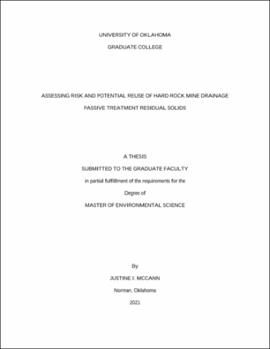| dc.description.abstract | Ecologically engineered mine drainage passive treatment systems rely on a series of biogeochemical reactions to decrease concentrations of ecotoxic trace metals and have proven to be an effective way to improve water quality in watersheds impacted by mining, especially in areas where access or funding is limited. Passive treatment systems require minimal regular maintenance, but occasional rehabilitative maintenance is necessary to ensure continued efficacy of the systems. These efforts include addressing residual solids by removal of iron oxyhydroxides from oxidation ponds and replacing of spent organic material from vertical flow bioreactors. In this study, iron oxyhydroxides and organic materials from two passive treatment systems located in the Tar Creek Superfund Site in the Tri-State Lead-Zinc Mining District were examined for total and leachable trace metals concentrations. The USEPA’s toxicity characteristic leaching procedure (TCLP) and synthetic precipitation leaching procedure (SPLP), as well as the USGS’s field leach test (FLT), were performed to evaluate the leachability of arsenic, cadmium, lead, manganese, nickel, zinc, and other trace metals from the residual solids. Biochar, municipal biosolids, and coal combustion residuals (CCR) were added to the solids to attempt to increase metals sorption and decrease leaching. The leachate produced from TCLP tests did not exceed Resource Conservation and Recovery Act limits for any of the contaminants of concern, but SPLP and FLT leachates did exceed some guidelines from the Oklahoma Water Resources Board. The addition of biochar, biosolids, and CCR did not decrease leaching of metals and in some cases increased leaching of contaminants of concern. Although it is not necessary to dispose of the mine drainage residual solids examined in this study in a hazardous waste repository, further research is necessary to determine the feasibility of reuse of the solids in subaqueous or subaerial environments. | en_US |
